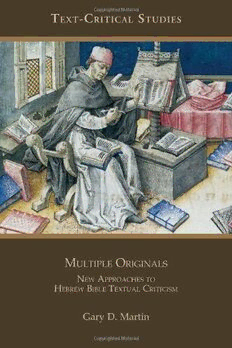
Multiple Originals: New Approaches to Hebrew Bible Textual Criticism PDF
Preview Multiple Originals: New Approaches to Hebrew Bible Textual Criticism
M O ultiple riginals Text-Critical Studies Editor Sidnie White Crawford Volume 7 M O ultiple riginals M O ultiple riginals New Approaches to Hebrew Bible Textual Criticism Gary D. Martin Society of Biblical Literature Atlanta M O ultiple riginals Copyright © 2010 by the Society of Biblical Literature All rights reserved. No part of this work may be reproduced or transmitted in any form or by any means, electronic or mechanical, including photocopying and recording, or by means of any information storage or retrieval system, except as may be expressly permitted by the 1976 Copyright Act or in writing from the publisher. Requests for permission should be addressed in writing to the Rights and Permissions Office, Society of Biblical Literature, 825 Houston Mill Road, Atlanta, GA 30329, USA. Library of Congress Cataloging-in-Publication Data Martin, Gary D. Multiple originals : new approaches to Hebrew Bible textual criti- cism / by Gary D. Martin. p. cm. — (Society of biblical literature. Text-critical studies ; no. 7) Includes bibliographical references and index. ISBN 978-1-58983-513-9 (paper binding : alk. paper) — ISBN 978-1-58983-514-6 (electronic format : alk. paper) 1. Bible. O.T—Criticism, Textual. I. Title. BS1136.M35 2010 221.4’046—dc22 2010042308 Printed on acid-free, recycled paper conforming to ANSI/NISO Z39.48-1992 (R1997) and ISO 9706:1994 CONTENTS Lists of Tables & Figures................................................................................vii Preface................................................................................................................ix Acknowledgements.........................................................................................xi Abbreviations.................................................................................................xiii Introduction.......................................................................................................1 PART ONE THEORETICAL MODELS.........................................................9 1 In Search of the Original..............................................................................11 2 Theories and Methods of Orality...............................................................63 PART TWO MULTIVALENCES OF MEANING......................................77 3 Split Visual—Aural/Oral Issues in Hebrew Texts.................................79 4 Split Visual—Aural/Oral Tradition in the Song of Songs.....................99 5 Christian Interpretation History of Song 1:2..........................................137 6 Jewish Interpretation History of Song 1:2...............................................161 7 Textual Conversion: The Christian Reading Becomes the Jewish Reading........................................................................................167 8 Arguments for the “Equivocum” of (cid:71)(cid:71) in the Song............................183 9 More Multivalence in the Song................................................................193 PART THREE MULTIVALENCES OF TEXT...........................................203 10 Textual Theories and the Decalogue.....................................................205 11 Textual Categories of Decalogue Manuscripts.....................................231 12 Application of Formulaic Methods to Decalogue Texts.....................237 13 Letter Confusion in the Prophets...........................................................249 v MULTIPLE ORIGINALS PART FOUR AGENDAS.............................................................................263 14 Audiences and Agendas..........................................................................265 15 To Where from Here?..............................................................................271 Appendix 1: Extended Citations for Chapter 1.........................................277 Appendix 2: Sources for English and German Bibles..............................281 Appendix 3: Decalogue Text Comparison.................................................285 Bibliography..................................................................................................317 Index of Modern Authors............................................................................333 Index of Biblical References.........................................................................337 LISTS OF TABLES & FIGURES Table 1: Frequency of “differ-vocal” by Book in BHQ...............................90 Table 2: Oldest Manuscripts of Song 1:2....................................................102 Table 3: Patrologia Latina Database, Old Latin & Vulgate Readings....156 Table 4: Patrologia Latina Database, Nova Vulgata Readings................156 Table 5: Percent Total Variants in Decalogue Manuscripts.....................226 Table 6: Percent Orthographic Variants in Decalogue Manuscripts......227 Table 7: Percent Non-Orthographic Variants in Decalogue Manuscripts.....................................................................................228 Table 8: Correlation Between Orthographic and Non-Orthographic Variants..........................................................229 Figure 1: OCLC Records for Oral Studies by Decade (Keywords: “oral Poetry,” “oral tradition,” “oral literature”).........................64 Figure 2: OCLC Records for “Orality” by Decade......................................64 Figure 3: OCLC Records for “Textual Criticism” (By century from 1506–1805; by decade thereafter)....................................................65 Figure 4: OCLC Comparison: Oral Studies vs. Textual Criticism............65 Figure 5: Labat, Development of the GAL-4 Sign.....................................118 Figure 6: Graph of Orthographic Variants.................................................227 Figure 7: Graph of Non-Orthographic Variants.......................................228 vii PREFACE This book aims not only to underscore shortcomings in those prac- tices of textual criticism that operate predominantly from a reductionist view of text, but also to offer theoretical and practical approaches to account for multivalent realities of textual origins that are generally overlooked in the text-critical enterprise. Typically, a text-critical edition presents to the user a single primary text block thought to represent the closest possible approximation to a putative original text. The assump- tion is that, among variant extant textual witnesses, there can be only one correct reading. This book challenges that assumption on two fronts, which I categorize as multivalences of meaning and multivalences of text. Thus, I argue that in reconstructing textual histories of early Jewish writings, scholars need to become more alert to the possibility that tex- tual variations in their earliest known historical contexts are not necessarily the results of intentional or unintential scribal intrusions into a hypothetical pristine original. Current text-critical practices suppress multivalences as a result of a narrow a priori view of textual origins. In some cases multivalences can be demonstrated to have been intended by the composer, in other cases multivalences of texts during the periods from which our earliest extant manuscripts derive simply fell within certain limits of acceptable variability by those who valued and transmitted those texts. Therefore these do not need to be corrected or reduced to univalent readings. Variant readings must not always be thought of as competing for the exalted status of singular original when they rather represent a multivalent original. ix
